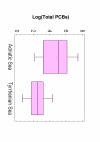Estrogen-like activity of seafood related to environmental chemical contaminants
- PMID: 16573822
- PMCID: PMC1484473
- DOI: 10.1186/1476-069X-5-9
Estrogen-like activity of seafood related to environmental chemical contaminants
Abstract
Background: A wide variety of environmental pollutants occur in surface waters, including estuarine and marine waters. Many of these contaminants are recognised as endocrine disrupting chemicals (EDCs) which can adversely affect the male and female reproductive system by binding the estrogen receptor and exhibiting hormone-like activities. In this study the estrogenic activity of extracts of edible marine organisms for human consumption from the Mediterranean Sea was assayed.
Methods: Marine organisms were collected in two different areas of the Mediterranean Sea. The estrogenic activity of tissues was assessed using an in vitro yeast reporter gene assay (S. cerevisiae RMY 326 ER-ERE). Concentrations of polychlorinated biphenyls (PCBs) (congeners 28, 52, 101, 118, 138, 153, 180) in fish tissue was also evaluated.
Results: Thirty-eight percent of extracts showed a hormone-like activity higher than 10% of the activity elicited by 10 nM 17b-estradiol (E2) used as control. Total PCB concentrations ranged from 0.002 up to 1.785 ng/g wet weight. Chemical analyses detected different levels of contamination among the species collected in the two areas, with the ones collected in the Adriatic Sea showing concentrations significantly higher than those collected in the Tyrrhenian Sea (p < 0.01).
Conclusion: The more frequent combination of chemicals in the samples that showed higher estrogenic activity was PCB 28, PCB 101, PCB 153, PCB 180. The content of PCBs and estrogenic activity did not reveal any significant correlation.
Figures







Similar articles
-
Monitoring of polychlorinated biphenyl contamination and estrogenic activity in water, commercial feed and farmed seafood.Environ Monit Assess. 2008 Sep;144(1-3):445-53. doi: 10.1007/s10661-007-0007-6. Epub 2007 Nov 13. Environ Monit Assess. 2008. PMID: 17999158
-
Bioaccumulation of PCBs and chlorinated pesticides in seals, fishes and invertebrates from the White Sea, Russia.Sci Total Environ. 2003 May 1;306(1-3):111-31. doi: 10.1016/S0048-9697(02)00488-6. Sci Total Environ. 2003. PMID: 12699922
-
Persistent organic pollutants in edible marine species from the Gulf of Naples, Southern Italy.Sci Total Environ. 2005 May 1;343(1-3):83-95. doi: 10.1016/j.scitotenv.2004.10.007. Epub 2004 Dec 2. Sci Total Environ. 2005. PMID: 15862838
-
Shellfish and residual chemical contaminants: hazards, monitoring, and health risk assessment along French coasts.Rev Environ Contam Toxicol. 2011;213:55-111. doi: 10.1007/978-1-4419-9860-6_3. Rev Environ Contam Toxicol. 2011. PMID: 21541848 Review.
-
Polychlorinated biphenyls (PCBs) in San Francisco Bay.Environ Res. 2007 Sep;105(1):67-86. doi: 10.1016/j.envres.2007.01.013. Epub 2007 Apr 23. Environ Res. 2007. PMID: 17451673 Review.
Cited by
-
Estrogenic evaluation and organochlorine identification in blubber of North Sea harbour porpoise (Phocoena phocoena) stranded on the North Sea coast.Biomed Res Int. 2015;2015:438295. doi: 10.1155/2015/438295. Epub 2015 May 17. Biomed Res Int. 2015. PMID: 26075240 Free PMC article.
-
Monitoring of polychlorinated biphenyl contamination and estrogenic activity in water, commercial feed and farmed seafood.Environ Monit Assess. 2008 Sep;144(1-3):445-53. doi: 10.1007/s10661-007-0007-6. Epub 2007 Nov 13. Environ Monit Assess. 2008. PMID: 17999158
References
-
- United States Environmental Protection Agency, Office of Water. Update: National Listing of Fish and Wildlife Advisories EPA-823-F-03-003. 2003.
Publication types
MeSH terms
Substances
LinkOut - more resources
Full Text Sources
Molecular Biology Databases

